Climatically-Controlled River Terraces in Eastern Australia
Abstract
1. Introduction
2. Materials and Methods
2.1. Site Selection and Fieldwork
2.2. Chronology
3. Results
3.1. Integrity of Chronology
3.2. Valley Floor Characteristics
3.3. Alluvial Sedimentology and Chronology
4. Discussion
4.1. Regional Correlation in Terrace Abandonment
4.2. Relationships to Late Quaternary Climatic Changes
4.3. Alternative Drivers of Terrace Abandonment
4.4. Modern and Late Holocene Floodplain Dynamics
4.5. Comparison to Terrace Abandonment in Other Climatic Regions
5. Conclusions
Supplementary Materials
Author Contributions
Funding
Acknowledgments
Conflicts of Interest
References
- Malatesta, L.C.; Prancevic, J.P.; Avouac, J.-P. Autogenic entrenchment patterns and terraces due to coupling with lateral erosion in incising alluvial channels. J. Geophys. Res. Earth Surf. 2017, 122, 335–355. [Google Scholar] [CrossRef]
- Schumm, S.A. The Fluvial System; Wiley: New York, NY, USA, 1977. [Google Scholar]
- Vandenberghe, J.; Cordier, S.; Bridgland, D.R. Extrinsic and intrinsic forcing of fluvial development: Understanding natural and anthropogenic influences. Proc. Geol. Assoc. 2010, 121, 107–112. [Google Scholar] [CrossRef]
- Brierley, G.J.; Fryirs, K. Geomorphology and River Management: Application of the Rivers Styles Framework; Blackwell Publishing Ltd.: Malden, MA, USA, 2005. [Google Scholar]
- Cooke, R.U.; Reeves, R.W. Arroyos and environmental change. Oxford 1976, 328, 520–557. [Google Scholar]
- Dühnforth, M.; Anderson, R.S.; Ward, D.J.; Blum, A. Unsteady late pleistocene incision of streams bounding the colorado front range from measurements of meteoric and in situ 10be. J. Geophys. Res. Earth Surf. 2012, 117. [Google Scholar] [CrossRef]
- Malatesta, L.C.; Avouac, J.P.; Brown, N.D.; Breitenbach, S.F.M.; Pan, J.; Chevalier, M.L.; Rhodes, E.; Saint-Carlier, D.; Zhang, W.; Charreau, J.; et al. Lag and mixing during sediment transfer across the tian shan piedmont caused by climate-driven aggradation-incision cycles. Basin Res. 2017. [Google Scholar] [CrossRef]
- Maddy, D.; Bridgland, D.; Westaway, R. Uplift-driven incision and climate-controlled river terrace development in the Thames Valley, UK. Quat. Int. 2001, 79, 23–36. [Google Scholar] [CrossRef]
- Bridgland, D.R.; Westaway, R. Climatically controlled river terrace staircases: A worldwide quaternary phenomenon. Geomorphology 2008, 98, 285–315. [Google Scholar] [CrossRef]
- Hanson, P.R.; Mason, J.A.; Goble, R.J. Fluvial terrace formation along wyoming’s laramie range as a response to increased late pleistocene flood magnitudes. Geomorphology 2006, 76, 12–25. [Google Scholar] [CrossRef]
- Macklin, M.G.; Lewin, J.; Jones, A.F. River entrenchment and terrace formation in the uk holocene. Quat. Sci. Rev. 2013, 76, 194–206. [Google Scholar] [CrossRef]
- Macklin, M.G.; Lewin, J.; Woodward, J.C. The fluvial record of climate change. Philos. Trans. Ser. A Math. Phys. Eng. Sci. 2012, 370, 2143–2172. [Google Scholar] [CrossRef] [PubMed]
- Vandenberghe, J. The relation between climate and river processes, landforms and deposits. Quat. Int. 2002, 91, 17–23. [Google Scholar] [CrossRef]
- Czarnota, K.; Roberts, G.G.; White, N.J.; Fishwick, S. Spatial and temporal patterns of australian dynamic topography from river profile modeling. J. Geophys. Res. Solid Earth 2014, 119, 1384–1424. [Google Scholar] [CrossRef]
- Nott, J.; Young, R.; McDougall, I. Wearing down, wearing back, and gorge extension in the long-term denudation of a highland mass: Quantitative evidence from the Shoalhaven catchment, Southeast Australia. J. Geol. 1996, 104, 224–232. [Google Scholar] [CrossRef]
- Peel, M.C.; McMahon, T.A.; Finlayson, B.L. Continental differences in the variability of annual runoff-update and reassessment. J. Hydrol. 2004, 295, 185–197. [Google Scholar] [CrossRef]
- Rustomji, P.; Bennett, N.; Chiew, F. Flood variability east of australia’s great dividing range. J. Hydrol. 2009, 374, 196–208. [Google Scholar] [CrossRef]
- Cohen, T.J.; Nanson, G.C. Topographically associated but chronologically disjunct late quaternary floodplains and terraces in a partly confined valley, south-eastern australia. Earth Surf. Process. Landf. 2008, 33, 424–443. [Google Scholar] [CrossRef]
- Kermode, S.J.; Cohen, T.J.; Reinfelds, I.V.; Nanson, G.C.; Pietsch, T.J. Alluvium of antiquity: Polycyclic terraces in a confined bedrock valley. Geomorphology 2012, 139–140, 471–483. [Google Scholar] [CrossRef]
- Cheetham, M.D.; Keene, A.F.; Erskine, W.D.; Bush, R.T.; Fitzsimmons, K.; Jacobsen, G.E.; Fallon, S.J. Resolving the holocene alluvial record in southeastern australia using luminescence and radiocarbon techniques. J. Quat. Sci. 2010, 25, 1160–1168. [Google Scholar] [CrossRef]
- Nanson, G.C.; Cohen, T.J.; Doyle, C.J.; Price, D.M. Alluvial evidence of major late-quaternary climate and flow-regime changes on the coastal rivers of New South Wales, Australia. In Palaeohydrology: Understanding Global Change; Gregory, K.J., Benito, G., Eds.; John Wiley & Sons, Ltd.: Chichester, UK, 2003; pp. 233–258. [Google Scholar]
- Cohen, T.J.; Nanson, G.C. Mind the gap: An absence of valley-fill deposits identifying the holocene hypsithermal period of enhanced flow regime in southeastern australia. Holocene 2007, 17, 411–418. [Google Scholar] [CrossRef]
- Hughes, K.; Croke, J.C.; Bartley, R.; Thompson, C.J.; Sharma, A. Alluvial terrace preservation in the wet tropics, northeast queensland, australia. Geomorphology 2015, 248, 311–326. [Google Scholar] [CrossRef]
- Leonard, S.; Nott, J. Rapid cycles of episodic adjustment: Understanding the holocene fluvial archive of the daintree river of northeastern australia. Holocene 2015, 25, 1208–1219. [Google Scholar] [CrossRef]
- Nott, J.; Hayne, M. High frequency of ‘super-cyclones’ along the great barrier reef over the past 5000 years. Nature 2001, 413, 508–512. [Google Scholar] [CrossRef] [PubMed]
- Kershaw, A.P. Environmental change in greater australia. Antiquity 1995, 69, 656–675. [Google Scholar] [CrossRef]
- Kershaw, A.P.; D’Costa, D.M.; McEwen Mason, J.R.C.; Wagstaff, B.E. Palynological evidence for quaternary vegetation and environments of mainland southeastern australia. Quat. Sci. Rev. 1991, 10, 391–404. [Google Scholar] [CrossRef]
- Petherick, L.; Bostock, H.; Cohen, T.J.J.; Fitzsimmons, K.; Tibby, J.; Fletcher, M.S.S.; Moss, P.; Reeves, J.; Mooney, S.; Barrows, T.; et al. Climatic records over the past 30ka from temperate australia—A synthesis from the oz-intimate workgroup. Quat. Sci. Rev. 2013, 74, 58–77. [Google Scholar] [CrossRef]
- Reeves, J.M.; Barrows, T.T.; Cohen, T.J.; Kiem, A.S.; Bostock, H.C.; Fitzsimmons, K.E.; Jansen, J.D.; Kemp, J.; Krause, C.; Petherick, L.; et al. Climate variability over the last 35,000 years recorded in marine and terrestrial archives in the australian region: An oz-intimate compilation. Quat. Sci. Rev. 2013, 74, 21–34. [Google Scholar] [CrossRef]
- Kershaw, A.P.; McKenzie, G.M.; Porch, N.; Roberts, R.G.; Brown, J.; Heijnis, H.; Orr, M.L.; Jacobsen, G.; Newall, P.R. A high-resolution record of vegetation and climate through the last glacial cycle from Caledonia Fen, Southeastern Highlands of Australia. J. Quat. Sci. 2007, 22, 481–500. [Google Scholar] [CrossRef]
- Moss, P.T.; Tibby, J.; Petherick, L.; McGowan, H.A.; Barr, C. Late quaternary vegetation history of North Stradbroke Island, Queensland, Eastern Australia. Quat. Sci. Rev. 2013, 74, 257–272. [Google Scholar] [CrossRef]
- Turney, C.S.M.; Kershaw, A.P.; Clemens, S.C.; Branch, N.; Moss, P.T.; Fifield, L.K. Millennial and orbital variations of el niño/southern oscillation and high-latitude climate in the last glacial period. Nature 2004, 428, 306–310. [Google Scholar] [CrossRef] [PubMed]
- Jones, R.; Bowler, J.; McMahon, T. A high resolution holocene record of p/e ratio from Closed Lakes, Western Victoria. Palaeoclimates 1998, 3, 51–82. [Google Scholar]
- Wilkins, D.; Gouramanis, C.; De Deckker, P.; Fifield, L.K.; Olley, J. Holocene lake-level fluctuations in Lakes Keilambete and Gnotuk, Southwestern Victoria, Australia. Holocene 2013, 23, 784–795. [Google Scholar] [CrossRef]
- Wyrwoll, K.-H.H.; Miller, G.H. Initiation of the australian summer monsoon 14,000 years ago. Quat. Int. 2001, 83–85, 119–128. [Google Scholar] [CrossRef]
- Woodward, C.; Shulmeister, J.; Bell, D.; Haworth, R.; Jacobsen, G.; Zawadzki, A. A holocene record of climate and hydrological changes from Little Llangothlin Lagoon, South Eastern Australia. Holocene 2014, 24, 1–10. [Google Scholar] [CrossRef]
- Reeves, J.M.; Bostock, H.C.; Ayliffe, L.K.; Barrows, T.T.; De Deckker, P.; Devriendt, L.S.; Dunbar, G.B.; Drysdale, R.N.; Fitzsimmons, K.E.; Gagan, M.K.; et al. Palaeoenvironmental change in tropical australasia over the last 30,000 years—A synthesis by the oz-intimate group. Quat. Sci. Rev. 2013, 74, 97–114. [Google Scholar] [CrossRef]
- Harvey, J.E.; Pederson, J.L.; Rittenour, T.M. Exploring relations between arroyo cycles and canyon paleoflood records in buckskin wash, utah: Reconciling scientific paradigms. Bull. Geol. Soc. Am. 2011, 123, 2266–2276. [Google Scholar] [CrossRef]
- Erskine, W.D.; Livingstone, E.A. In-channel benches: The role of floods in their formation and destruction on bedrock- confined rivers. In Varieties of Fluvial Form; Miller, A.J., Gupta, A., Eds.; John Wiley & Sons, Ltd.: Chichester, UK, 1999; pp. 445–476. [Google Scholar]
- Nanson, G.C. Episodes of vertical accretion and catastrophic stripping: A model of disequilibrium flood-plain development. Geol. Soc. Am. Bull. 1986, 97, 1467–1475. [Google Scholar] [CrossRef]
- Thompson, C.J.; Croke, J.C.; Fryirs, K.; Grove, J.R. A channel evolution model for subtropical macrochannel systems. CATENA 2016, 139, 199–213. [Google Scholar] [CrossRef]
- Erskine, W.D.; Saynor, M. Effects of catastrophic floods on sediment yields in Southeastern Australia. In Erosion and Sediment Yield: Global and Regional Perspectives, Proceedings of the International Symposium, Exeter, UK, 15–19 July 1996; IAHS: London, UK; p. 381.
- Baker, V.R. Stream-channel responses to floods, with examples from central texas. Geol. Soc. Am. Bull. 1977, 88, 1057–1071. [Google Scholar] [CrossRef]
- Croke, J.C.; Fryirs, K.; Thompson, C.J. Channel-floodplain connectivity during an extreme flood event: Implications for sediment erosion, deposition, and delivery. Earth Surf. Process. Landf. 2013, 38, 1444–1456. [Google Scholar] [CrossRef]
- Croke, J.C.; Reinfelds, I.; Thompson, C.J.; Roper, E. Macrochannels and their significance for flood-risk minimisation: Examples from Southeast Queensland and New South Wales, Australia. Stoch. Environ. Res. Risk Assess. 2014, 28, 99–112. [Google Scholar] [CrossRef]
- Daley, J.S.; Croke, J.; Thompson, C.; Cohen, T.; Macklin, M.; Sharma, A. Late quaternary channel and floodplain formation in a partly confined Subtropical River, Eastern Australia. J. Quat. Sci. 2017, 32, 729–743. [Google Scholar] [CrossRef]
- Grove, J.R.; Croke, J.C.; Thompson, C.J. Quantifying different riverbank erosion processes during an extreme flood event. Earth Surf. Process. Landf. 2013. [Google Scholar] [CrossRef]
- Thompson, C.J.; Croke, J.C. Geomorphic effects, flood power, and channel competence of a catastrophic flood in confined and unconfined reaches of the Upper Lockyer Valley, Southeast Queensland, Australia. Geomorphology 2013, 197, 156–169. [Google Scholar] [CrossRef]
- Croke, J.C.; Todd, P.; Thompson, C.J.; Watson, F.; Denham, R.; Khanal, G. The use of multi temporal lidar to assess basin-scale erosion and deposition following the catastrophic January 2011 Lockyer Flood, Se Queensland, Australia. Geomorphology 2013, 184, 111–126. [Google Scholar] [CrossRef]
- Heritage, G.L.L.; Broadhurst, L.J.J.; Birkhead, A.L.L. The influence of contemporary flow regime on the geomorphology of the Sabie River, South Africa. Geomorphology 2001, 38, 197–211. [Google Scholar] [CrossRef]
- Van Niekerk, A.W.; Heritage, G.L.; Broadhurst, L.J.; Moon, B.P. Bedrock anastomosing channel systems: Morphology and dynamics in the Sabie River, Mpumalanga Province, South Africa. In Varieties of Fluvial Form; Miller, A.J., Gupta, A., Eds.; John Wiley & Sons, Ltd.: Chichester, UK, 1999; pp. 33–52. [Google Scholar]
- Gupta, A. Magnitude, frequency, and special factors affecting channel form and processes in the seasonal tropics. In Natural and Anthropogenic Influences in Fluvial Geomorphology; Costa, J.E., Miller, A.J., Potter, K.W., Wilcock, P.R., Eds.; American Geophysical Union: Washington, DC, USA, 1995; pp. 125–136. [Google Scholar]
- Hoyle, J.; Brooks, A.P.; Brierley, G.J.; Fryirs, K.; Lander, J. Spatial variability in the timing, nature and extent of channel response to typical human disturbance along the Upper Hunter River, New South Wales, Australia. Earth Surf. Process. Landf. 2008, 33, 868–889. [Google Scholar] [CrossRef]
- Woodyer, K.D.D. Bankfull frequency in rivers. J. Hydrol. 1968, 6, 114–142. [Google Scholar] [CrossRef]
- Harden, T.; Macklin, M.G.; Baker, V.R. Holocene flood histories in South-Western USA. Earth Surf. Process. Landf. 2010, 35, 707–716. [Google Scholar] [CrossRef]
- Crimp, S.J.; Day, K.A. Evaluation of multi-decadal variability in rainfall in queensland using indices of el nino-southern oscillation and inter-decadal variability. In Science for Drought, Proceedings of the National Drought Forum’; Stone, R.C., Partridge, I., Eds.; National Drought Forum: Brisbane, Australia, 2003; pp. 106–115. [Google Scholar]
- Kiem, A.S. Multi-decadal variability of flood risk. Geophys. Res. Lett. 2003, 30, 1035–1035. [Google Scholar] [CrossRef]
- Power, S.; Casey, T.; Folland, C.; Colman, A.; Mehta, V. Inter-decadal modulation of the impact of enso on australia. Clim. Dyn. 1999, 15, 319–324. [Google Scholar] [CrossRef]
- Risbey, J.; Karoly, D.; Reynolds, A.; Braganza, K. Drought and climate change. In Proceedings of the National Drought Forum, Brisbane, Australia, 15–16 April 2003; Stone, R.C., Partridge, I., Eds.; National Drought Forum: Brisbane, Australia, 2003; pp. 8–11. [Google Scholar]
- Daley, J.S. Late Quaternary Stream Channel Adjustment in Hydrologically Variable Catchments, Subtropical Australia; University of Queensland: Brisbane, Australia, 2018. [Google Scholar]
- Pasternack, G.B. Lower Yuba River Corridor Inundation Zones. Prepared for The Yuba County Water Agency; University of California: Davis, CA, USA, 2017. [Google Scholar]
- Weber, M.D.; Pasternack, G.B. 2014 Topographic Mapping of the Lower Yuba River. Prepared for the Yuba Accord River Management Team; University of California: Davis, CA, USA, 2016. [Google Scholar]
- Aitken, M.J. An Introduction to Optical Dating: The Dating of Quaternary Sediments by the Use of Photon-Stimulated Luminescence; Oxford Science Publications: Oxford, UK, 1998. [Google Scholar]
- Wallinga, J. Optically stimulated luminescence dating of fluvial deposits: A review. Boreas 2002, 31, 303–322. [Google Scholar] [CrossRef]
- Olley, J.M.; Pietsch, T.J.; Roberts, R.G. Optical dating of holocene sediments from a variety of geomorphic settings using single grains of quartz. Geomorphology 2004, 60, 337–358. [Google Scholar] [CrossRef]
- Pietsch, T.J. Optically stimulated luminescence dating of young (<500 years old) sediments: Testing estimates of burial dose. Quat. Geochronol. 2009, 4, 406–422. [Google Scholar]
- Galbraith, R.F. Graphical display of estimates having differing standard errors. Technometrics 1988, 30, 271–281. [Google Scholar] [CrossRef]
- Galbraith, R.F.; Laslett, G.M. Statistical models for mixed fission track ages. Nucl. Tracks Radiat. Meas. 1993, 21, 459–470. [Google Scholar] [CrossRef]
- Galbraith, R.F.; Roberts, R.G.; Laslett, G.M.; Yoshida, H.; Olley, J.M. Optical dating of single and multiple grains of quartz from Jinmium Rock Shelter, Northern Australia, part 2, results and implications. Archaeometry 1999, 41, 339–364. [Google Scholar] [CrossRef]
- Roberts, H.M.; Wintle, A.G. Equivalent dose determinations for polymineralic fine-grains using the sar protocol: Application to a holocene sequence of the chinese loess plateau. Quat. Sci. Rev. 2001, 20, 859–863. [Google Scholar] [CrossRef]
- Murray, A.; Marten, R.; Johnston, A.; Martin, P. Analysis for naturally occuring radionuclides at environmental concentrations by gamma spectrometry. J. Radioanal. Nucl. Chem. 1987, 115, 263–288. [Google Scholar] [CrossRef]
- Stokes, S.; Ingram, S.; Aitken, M.J.; Sirocko, F.; Anderson, R.; Leuschner, D. Alternative chronologies for late quaternary (last interglacial–holocene) deep sea sediments via optical dating of silt-sized quartz. Quat. Sci. Rev. 2003, 22, 925–941. [Google Scholar] [CrossRef]
- Mejdahl, V. Thermoluminescence dating: Beta-dose attenuation in quartz grains. Archaeometry 1979, 21, 61–72. [Google Scholar] [CrossRef]
- Prescott, J.R.; Hutton, J.T. Cosmic ray contributions to dose rates for luminescence and ESR dating: Large depths and long-term time variations. Radiat. Meas. 1994, 23, 497–500. [Google Scholar] [CrossRef]
- Bowler, J.M.; Johnston, H.; Olley, J.M.; Prescott, J.R.; Roberts, R.G.; Shawcross, W.; Spooner, N.A. New ages for human occupation and climatic change at Lake Mungo, Australia. Nature 2003, 421, 837–840. [Google Scholar] [CrossRef] [PubMed]
- Stuiver, M.; Polach, H.A. Discussion; reporting of c-14 data. Radiocarbon 1977, 19, 355–363. [Google Scholar] [CrossRef]
- Reimer, P.J.; Bard, E.; Bayliss, A.; Beck, J.W.; Blackwell, P.G.; Bronk Ramsey, C.; Buck, C.E.; Cheng, H.; Edwards, R.L.; Friedrich, M.; et al. Intcal13 and marine13 radiocarbon age calibration curves 0–50,000 years cal BP. Radiocarbon 2013, 55, 1869–1887. [Google Scholar] [CrossRef]
- Croke, J.; Thompson, C.; Denham, R.; Haines, H.; Sharma, A.; Pietsch, T. Reconstructing a millennial-scale record of flooding in a single valley setting: The 2011 flood-affected Lockyer Valley, South-East Queensland, Australia. J. Quat. Sci. 2016, 31, e2919. [Google Scholar] [CrossRef]
- Kermode, S.J.; Cohen, T.J.; Reinfelds, I.V.; Jones, B.G. Modern depositional processes in a confined, flood-prone setting: Benches on the Shoalhaven River, NSW, Australia. Geomorphology 2015, 228, 470–485. [Google Scholar] [CrossRef]
- Croke, J.C.; Jansen, J.D.; Amos, K.; Pietsch, T.J. A 100 ka record of fluvial activity in the Fitzroy River Basin, Tropical Northeastern Australia. Quat. Sci. Rev. 2011, 30, 1681–1695. [Google Scholar] [CrossRef]
- Hughes, K.; Croke, J.C. How did rivers in the wet tropics (Ne Queensland, Australia) respond to climate changes over the past 30 000 years? J. Quat. Sci. 2017, 32, 744–759. [Google Scholar] [CrossRef]
- Warner, R.F. Radio-carbon dates for some fluvial and colluvial deposits in the Bellinger Valleys, New South Wales. Aust. J. Sci. 1970, 32, 368–369. [Google Scholar]
- Gibbard, P.L.; Lewin, J. River incision and terrace formation in the Late Cenozoic of Europe. Tectonophysics 2009, 474, 41–55. [Google Scholar] [CrossRef]
- Vandenberghe, J. River terraces as a response to climatic forcing: Formation processes, sedimentary characteristics and sites for human occupation. Quat. Int. 2015, 370, 3–11. [Google Scholar] [CrossRef]
- Chang, J.C.; Shulmeister, J.; Woodward, C.; Steinberger, L.; Tibby, J.; Barr, C. A chironomid-inferred summer temperature reconstruction from subtropical australia during the last glacial maximum (LGM) and the last deglaciation. Quat. Sci. Rev. 2015, 122, 282–292. [Google Scholar] [CrossRef]
- Woltering, M.; Atahan, P.; Grice, K.; Heijnis, H.; Taffs, K.; Dodson, J. Glacial and holocene terrestrial temperature variability in subtropical east australia as inferred from branched gdgt distributions in a sediment core from lake mckenzie. Quat. Res. 2014, 82, 132–145. [Google Scholar] [CrossRef]
- Field, E.; Tyler, J.; Gadd, P.S.; Moss, P.; McGowan, H.; Marx, S. Coherent patterns of environmental change at multiple organic spring sites in northwest australia: Evidence of indonesian-australian summer monsoon variability over the last 14,500 years. Quat. Sci. Rev. 2018, 196, 193–216. [Google Scholar] [CrossRef]
- Thomas, M.F. Understanding the impacts of late quaternary climate change in tropical and sub-tropical regions. Geomorphology 2008, 101, 146–158. [Google Scholar] [CrossRef]
- Thomas, M.F.; Nott, J.; Murray, A.S.; Price, D.M. Fluvial response to late quaternary climate change in Ne Queensland, Australia. Palaeogeogr. Palaeoclim. Palaeoecol. 2007, 251, 119–136. [Google Scholar] [CrossRef]
- Bureau of Meteorology. Rainfall Anomalies (mm)—Product of the National Climate Centre; Australian Government, Bureau of Meteorology: Melbourne, Australia, 2012.
- Beckmann, G.G. The Post-Tertiary History of brisbane And Surroundings; University of Queensland: Brisbane, Australia, 1959. [Google Scholar]
- Bowman, D.M.J.S. The impact of aboriginal landscape burning on the australian biota. New Phytol. 1998, 140, 385–410. [Google Scholar] [CrossRef]
- Chivas, A.R.; Garcı́a, A.; van der Kaars, S.; Couapel, M.J.J.; Holt, S.; Reeves, J.M.; Wheeler, D.J.; Switzer, A.D.; Murray-Wallace, C.V.; Banerjee, D.; et al. Sea-level and environmental changes since the last interglacial in the gulf of carpentaria, australia: An overview. Quat. Int. 2001, 83–85, 19–46. [Google Scholar] [CrossRef]
- Lewis, S.E.; Sloss, C.R.; Murray-Wallace, C.V.; Woodroffe, C.D.; Smithers, S.G. Post-glacial sea-level changes around the australian margin: A review. Quat. Sci. Rev. 2013, 74, 115–138. [Google Scholar] [CrossRef]
- Blum, M.D.; Aslan, A. Signatures of climate vs. Sea-level change within incised valley-fill successions: Quaternary examples from the texas gulf coast. Sediment. Geol. 2006, 190, 177–211. [Google Scholar] [CrossRef]
- Blum, M.D.; Törnqvist, T.E. Fluvial responses to climate and sea-level change: A review and look forward. J. Int. Assoc. Sedimentol. 2000, 47, 2–48. [Google Scholar] [CrossRef]
- Turney, C.S.M.; Hobbs, D. Enso influence on holocene aboriginal populations in queensland, australia. J. Archaeol. Sci. 2006, 33, 1744–1748. [Google Scholar] [CrossRef]
- Williams, A.N.; Mooney, S.D.; Sisson, S.A.; Marlon, J. Exploring the relationship between aboriginal population indices and fire in australia over the last 20,000 years. Palaeogeogr. Palaeoclim. Palaeoecol. 2015, 432, 49–57. [Google Scholar] [CrossRef]
- Williams, A.N.; Ulm, S.; Goodwin, I.D.; Smith, M. Hunter-gatherer response to late holocene climatic variability in Northern and Central Australia. J. Quat. Sci. 2010, 25, 831–838. [Google Scholar] [CrossRef]
- Allen, J.; O’Connell, J. Both half right:Updating the evidence for dating first human arrivals in Sahul. Aust. Archaeol. 2014, 79, 86–108. [Google Scholar] [CrossRef]
- Neal, R.; Stock, E. Pleistocene occupation in the South-East Queensland Coastal Region. Nature 1986, 323, 618. [Google Scholar] [CrossRef]
- Bird, R.B.; Bird, D.W.; Codding, B.F.; Parker, C.H.; Jones, J.H. The “fire stick farming” hypothesis: Australian aboriginal foraging strategies, biodiversity, and anthropogenic fire mosaics. Proc. Natl. Acad. Sci. USA 2008, 105, 14796–14801. [Google Scholar] [CrossRef] [PubMed]
- Bull, W.B. Discontinuous ephemeral streams. Geomorphology 1997, 19, 227–276. [Google Scholar] [CrossRef]
- Elliott, J.G.; Gellis, A.C.; Aby, S.B. Evolution of arroyos: Incised channels of the southwestern united states. In Incised River Channels: Processes, Forms, Engineering and Management; Darby, S.E., Simon, A., Eds.; Wiley: Chichester, UK, 1999; pp. 153–186. [Google Scholar]
- Waters, M.R. Alluvial chronologies and archaeology of the Gila River Drainage Basin, Arizona. Geomorphology 2008, 101, 332–341. [Google Scholar] [CrossRef]
- Macklin, M.G.; Fuller, I.C.; Lewin, J.; Maas, G.S.; Passmore, D.G.; Rose, J.; Woodward, J.C.; Black, S.; Hamlin, R.H.B.; Rowan, J.S. Correlation of fluvial sequences in the mediterranean basin over the last 200 ka and their relationship to climate change. Quat. Sci. Rev. 2002, 21, 1633–1641. [Google Scholar] [CrossRef]
- Macklin, M.G.; Lewin, J. Alluvial responses to the changing earth system. Earth Surf. Process. Landf. 2008, 33, 1374–1395. [Google Scholar] [CrossRef]
- Doğan, U. Fluvial response to climate change during and after the last glacial maximum in Central Anatolia, Turkey. Quat. Int. 2010, 222, 221–229. [Google Scholar] [CrossRef]
- Jain, M.; Tandon, S.K. Fluvial response to late quaternary climate changes, Western India. Quat. Sci. Rev. 2003, 22, 2223–2235. [Google Scholar] [CrossRef]
- Latrubesse, E.Μ.; Bocquentin, J.; Santos, J.C.R.; Ramonell, C.G. Paleoenvironmental model for the late cenozoic of southwestern amazonia: Paleontology and geology. Acta Amazon. 1997, 27, 103–117. [Google Scholar] [CrossRef]
- Kershaw, A.P. Climatic change and aboriginal burning in North-East Australia during the last two glacial/interglacial cycles. Nature 1986, 322, 47. [Google Scholar] [CrossRef]
- Ellerton, D.; Shulmeister, J.; Woodward, C.; Moss, P. Last glacial maximum and last glacial–interglacial transition pollen record from Northern NSW, Australia: Evidence for a humid late last glacial maximum and dry deglaciation in parts of Eastern Australia. J. Quat. Sci. 2017, 32, 717–728. [Google Scholar] [CrossRef]
- Petherick, L.M.; Moss, P.T.; McGowan, H.A. An extended last glacial maximum in Subtropical Australia. Quat. Int. 2016, 432, 1–12. [Google Scholar] [CrossRef]
- Vandenberghe, J. Climate forcing of fluvial system development: An evolution of ideas. Quat. Sci. Rev. 2003, 22, 2053–2060. [Google Scholar] [CrossRef]
- Westaway, R.; Bridgland, D.; Mishra, S. Rheological differences between archaean and younger crust can determine rates of quaternary vertical motions revealed by fluvial geomorphology. Terra Nova 2003, 15, 287–298. [Google Scholar] [CrossRef]
- Lewin, J.; Macklin, M.G. Preservation potential for late quaternary river alluvium. J. Quat. Sci. 2003, 18, 107–120. [Google Scholar] [CrossRef]
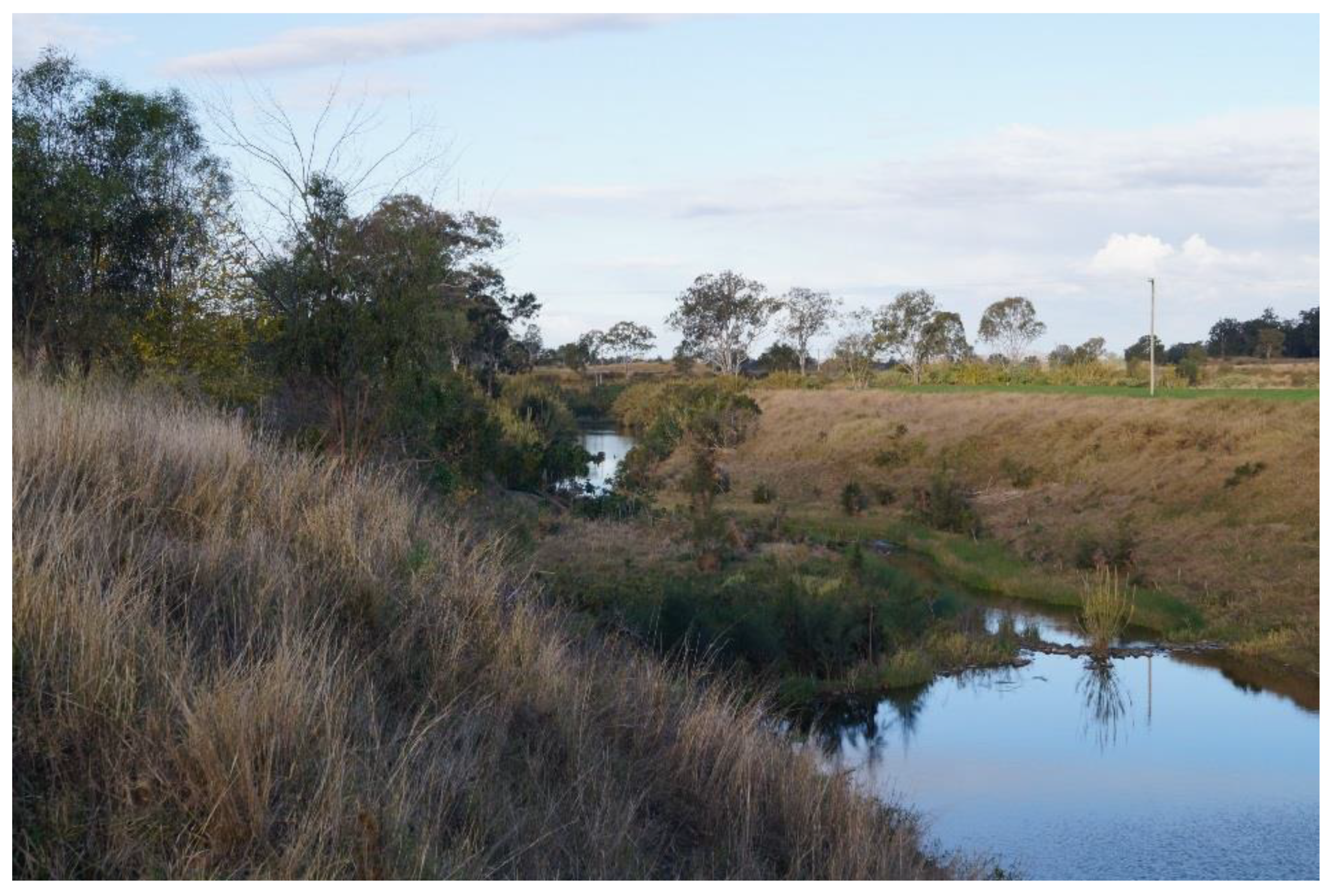
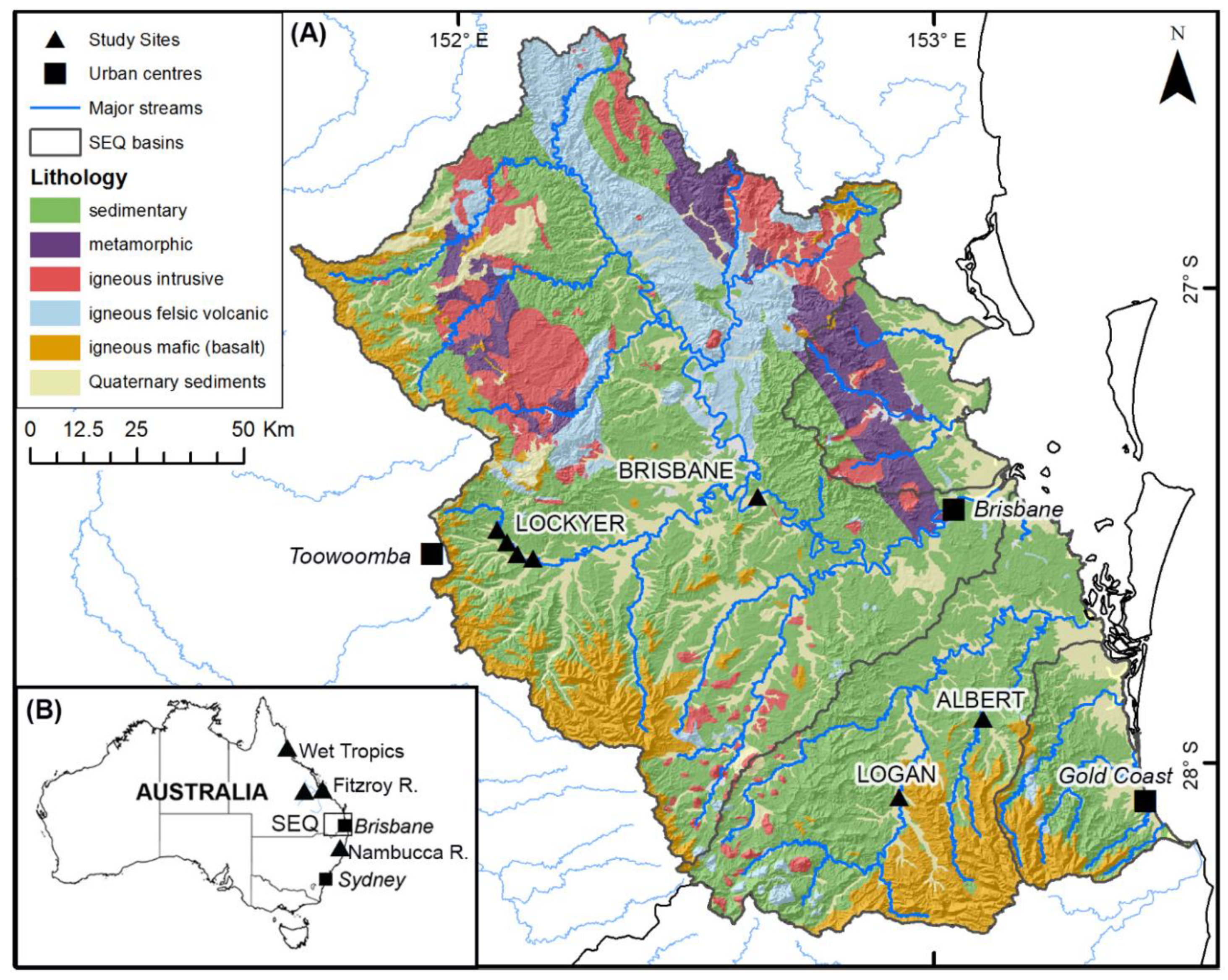
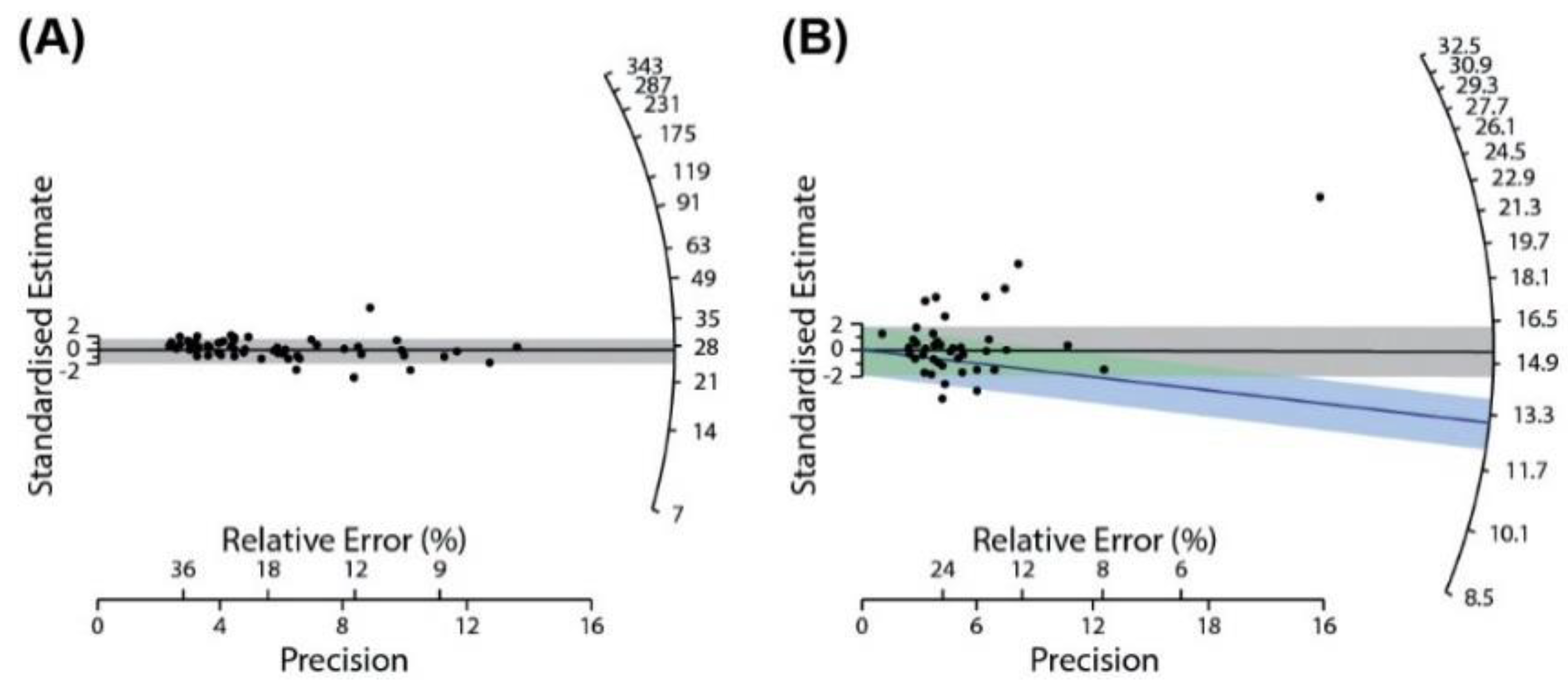
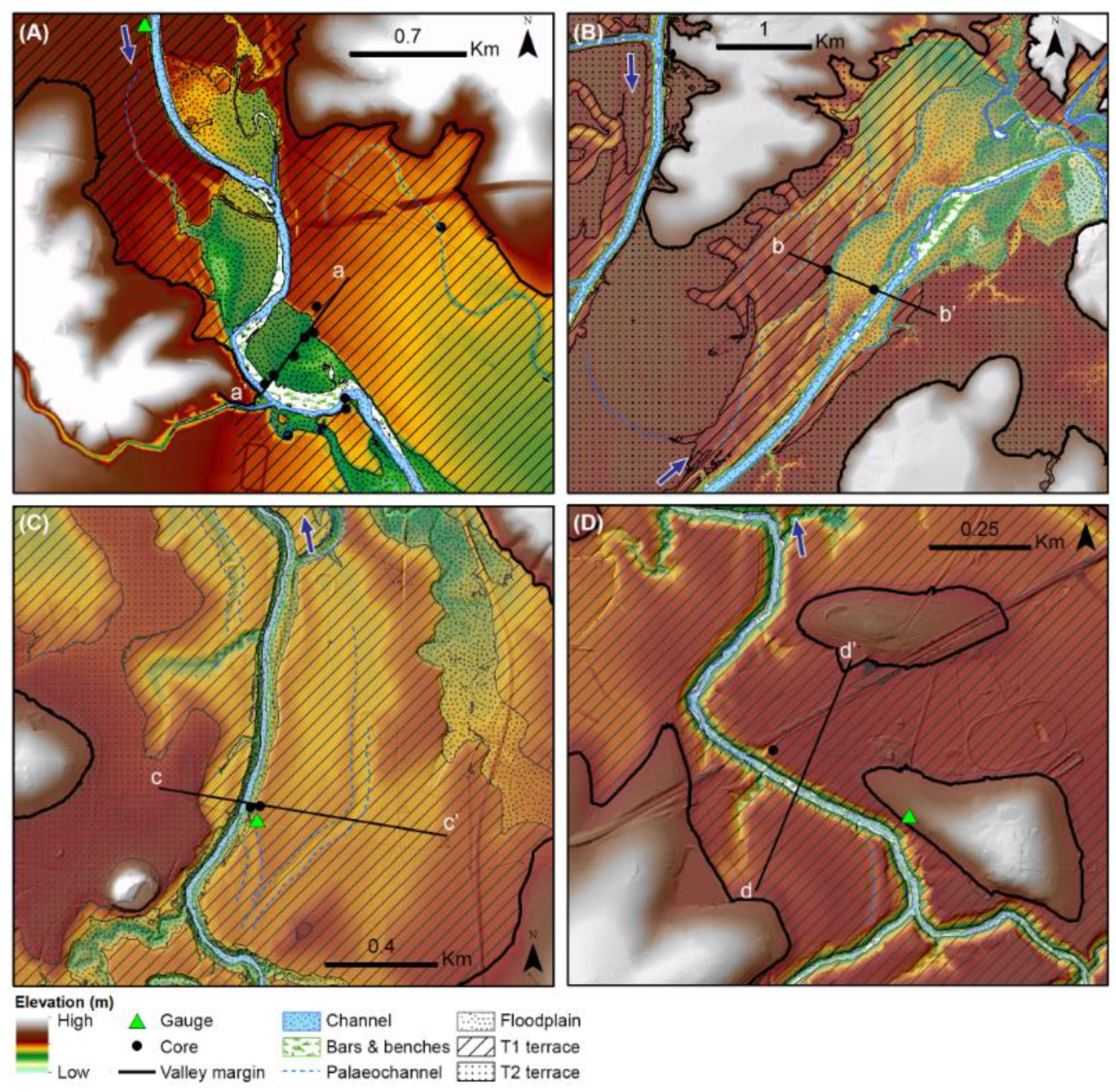
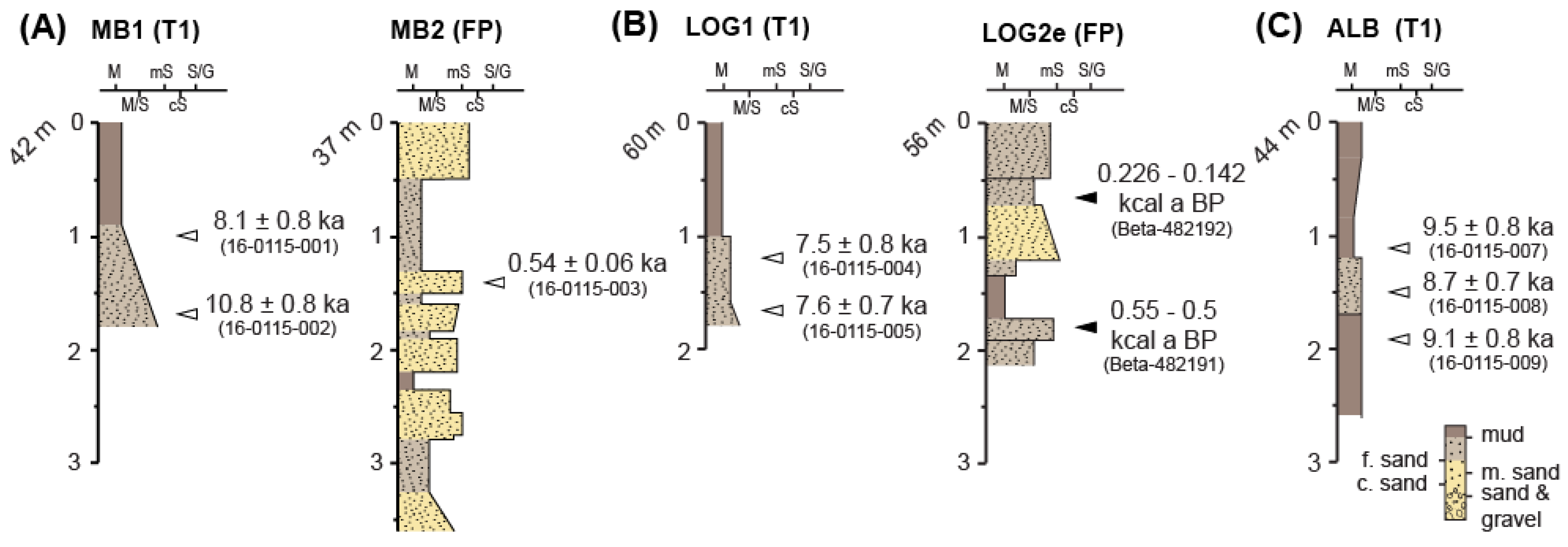
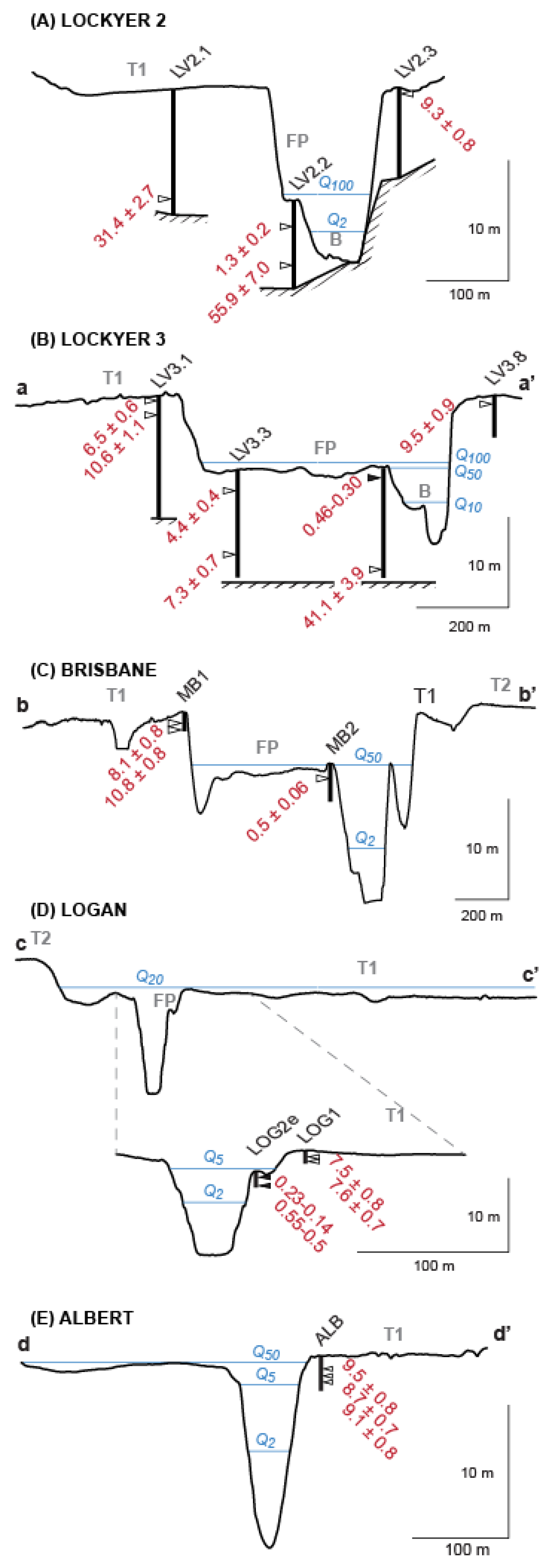
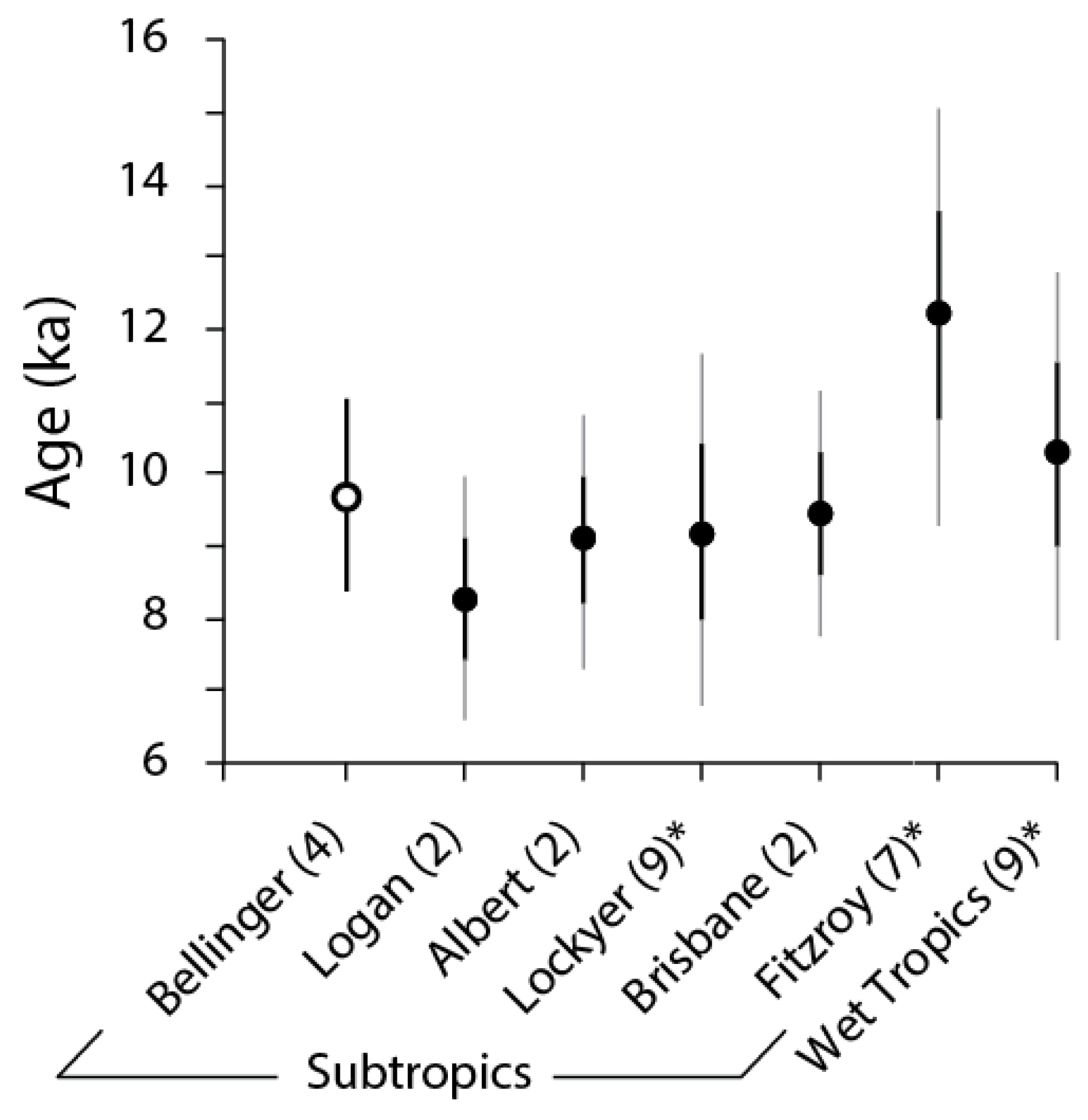

| Site Location | Lockyer Creek | Logan River | Albert River | Brisbane River |
|---|---|---|---|---|
| Gauge ID | 143203 | 145008 | 145102 | 143001 |
| Gauge Name | Helidon | Round Mountain | Bromfleet | Vernor |
| Drainage area (km) | 357 | 1262 | 544 | 10,172 |
| Distance upstream (km) | 99 | 125 | 47 | 131 |
| Elevation (m) | 129 | 44 | 28 | 18 |
| Slope (m·m−1) | 0.002 | 0.001 | 0.001 | 0.0002 |
| Stream order | 6 | 6 | 6 | 8 |
| Channel setting | partly confined | partly confined | partly confined | partly confined–unconfined |
| Bankfull AEP (a−1) | >200 | 20 | 40 | 48 |
| Bed load | mixed sand-cobble | m/c sand | m/c sand | mixed sand–cobble |
| Primary geology 1 | Lithofeldspathic labile and feldspathic labile sandstone; quartzose sandstone, siltstone, shale, minor coal, ferruginous oolite marker | Lithofeldspathic labile and feldspathic labile sandstone; quartzose sandstone, siltstone, shale, minor coal, ferruginous oolite marker | Lithofeldspathic labile and feldspathic labile sandstone; quartzose sandstone, siltstone, shale, minor coal, ferruginous oolite marker | Lithofeldspathic labile and feldspathic labile sandstone |
| Secondary geology 1 | Quartz-lithic and quartzose sandstone, quartz-rich granule conglomerate, silty sandstone, siltstone, claystone; carbonaceous siltstone and claystone | Alkali-olivine basalt | Alkali-olivine basalt | Feldspathic and lithic meta-arenite, metasiltstone and conglomerate proximal turbidites, with structurally intercalated or stratigraphically underlying chert, jasper and basic meta-volcanics. |
| Soils 2 | Fine textured alluvium—hardsetting brown and grey loam surface soil over neutral to alkaline clay | Fine textured alluvium—black earth and grey clays | Fine textured alluvium—black earth and grey clays | Fine textured alluvium—black earth and grey clays |
| Basin | Core ID | Lab Code | Depth (m) | Landform | Depositional Environment | Age (ka) | Method |
|---|---|---|---|---|---|---|---|
| Mid-Brisbane | MB1 | 16-0115-001 | 1.0 | Terrace | Overbank | 8.08 ± 0.77 | CAM |
| Overbank | 5.86 ± 0.80 | MAM | |||||
| MB1 | 16-0115-002 | 1.7 | Terrace | Overbank | 10.83 ± 0.84 | CAM | |
| MB2 | 16-0115-003 | 1.4 | Floodplain | Overbank | 0.54 ± 0.06 | MAM | |
| Logan | LOG1 | 16-0115-004 | 1.2 | Terrace | Overbank | 8.88 ± 0.81 | CAM |
| Overbank | 7.51 ± 0.82 | MAM | |||||
| LOG1 | 16-0115-005 | 1.6 | Terrace | Overbank | 7.61 ± 0.68 | CAM | |
| Albert | ALB | 16-0115-007 | 1.1 | Terrace | Overbank | 9.51 ± 0.82 | CAM |
| ALB | 16-0115-008 | 1.5 | Terrace | Overbank | 8.71 ± 0.66 | CAM | |
| ALB | 16-0115-009 | 1.9 | Terrace | Overbank | 9.08 ± 0.81 | CAM | |
| Lockyer [46] | LV1.1 | 14-0528-001 | 0.4 | Terrace | Overbank | 11.51 ± 1.29 | CAM |
| LV1.2 | 14-0596-005 | 5.7 | Floodplain | Basal | 7.97 ± 1.02 | MAM | |
| LV2.3 | 14-0596-015 | 0.2 | Terrace | Overbank | 9.25 ± 0.84 | CAM | |
| LV3.1 | 14-0596-001 | 0.4 | Terrace | Overbank | 6.45 ± 0.57 | MAM | |
| LV3.1 | 14-0528-010 | 2.1 | Terrace | Overbank | 10.60 ± 1.09 | MAM | |
| LV3.3 | 14-0528-008 | 9.4 | Floodplain | Basal | 7.34 ± 0.67 | MAM | |
| LV3.8 | 14-0528-003 | 0.4 | Terrace | Overbank | 9.50 ± 0.93 | CAM | |
| LV4.3 | 14-0596-007 | 2.0 | Terrace | Overbank | 10.01 ± 1.23 | MAM | |
| LV4.4 | 14-0596-012 | 10.3 | Floodplain | Basal | 10.08 ± 1.03 | MAM |
| Basin | Core #/Depth (m) | Lab Code | Material | pMc | δ13C (‰) | Conventional Age (a BP) ± 1σ Error | 95.4% Calibrated Age (cal. BP) [%] |
|---|---|---|---|---|---|---|---|
| Logan | LOG2/0.65 | BETA-482192 | Charred material | 97.18 | −24.3 | 230 ± 30 | 226–142 [67.8%] |
| 306–252 [27.2%] | |||||||
| 79–74 [0.4%] | |||||||
| LOG2/1.8 | BETA-482191 | Charred material | 93.5 | −25 | 540 ± 30 | 550–500 |
© 2018 by the authors. Licensee MDPI, Basel, Switzerland. This article is an open access article distributed under the terms and conditions of the Creative Commons Attribution (CC BY) license (http://creativecommons.org/licenses/by/4.0/).
Share and Cite
Daley, J.S.; Cohen, T.J. Climatically-Controlled River Terraces in Eastern Australia. Quaternary 2018, 1, 23. https://doi.org/10.3390/quat1030023
Daley JS, Cohen TJ. Climatically-Controlled River Terraces in Eastern Australia. Quaternary. 2018; 1(3):23. https://doi.org/10.3390/quat1030023
Chicago/Turabian StyleDaley, James S., and Tim J. Cohen. 2018. "Climatically-Controlled River Terraces in Eastern Australia" Quaternary 1, no. 3: 23. https://doi.org/10.3390/quat1030023
APA StyleDaley, J. S., & Cohen, T. J. (2018). Climatically-Controlled River Terraces in Eastern Australia. Quaternary, 1(3), 23. https://doi.org/10.3390/quat1030023






